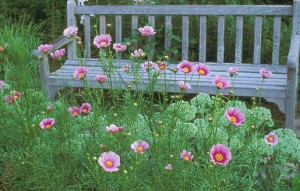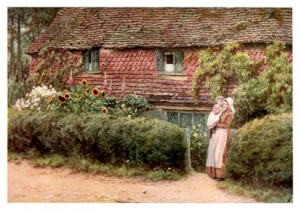Captivating Cottage Gardens
March 18, 2009 by admin
Filed under Cottage Gardening, Garden Design
Cottage gardens possess an allure unmatched by any other kind of garden. Maybe it comes from being the horticultural equivalent of a woman with an hourglass figure, or maybe it’s just because they’re packed with such a variety of plant life that they’re never the same two weeks in a row, but whatever the source of their mystique, cottage gardens draw people like bees to nectar.

Cosmos takes center stage in a sweet cottage garden scene
This spring I’m giving a series of lectures about cottage gardening, focusing primarily on a very particular cottage garden I designed and built starting in 2000. At nine years of age, it’s had plenty of time to mature and evolve. Many good gardening lessons can be drawn from it, and I’ll be sharing them with you over the coming months.
If you’re in (or plan to be in) southern New England this spring, check out my lecture schedule to see if you can’t fit one into your plans. Most of them are free, and you can’t do better than that!
To get things started, I’ll just say a few words about what a cottage garden is. The origins of the cottage garden go back hundreds of years to a time when most people grew a significant amount of their own food and made a great deal of their own household products—from soaps and dyes to medicines—mostly from plants. Cottage gardens are named for the country cottages around which they were found. Although cottage gardens as a phenomenon certainly weren’t restricted to the British Isles, we did inherit the cottage gardening tradition primarily from the British by virtue of our shared history.

An artist's depiction of a traditional British cottage garden
Several things characterized the traditional cottage garden. It was on the small side, informal and not “designed” in anything like the modern sense of the word; it was a garden belonging to a person of modest means; it was a mix of flowers, vegetables and herbs (although the word “herb” meant something different then—more on that later); the plants in it were procured cheaply, usually in the form of passalong cuttings, divisions and seeds from friends and family; and it was densely packed with plants in order to maximize the productivity of a limited space.
Today’s cottage gardens are often strictly ornamental, vegetables and herbs now having their source at the local grocery store. They can be large, upscale and filled with the most fashionable of exotic vegetation, or they can be spaces where every resident plant carries an association with a loved friend or relative who gave it as a gift. Despite these differences, cottage gardens still look a lot like their ancestors—a testament to the adaptability of a loosely defined garden style. In fact, the only real requirements for a cottage garden are that it have a blowsy, freewheeling look and a lot of different flowering things.
That’s all for now—I hope you’ll join me over the coming months as we look in depth at how to make captivating cottage gardens.


Hi Amy!
I attended your lecture in East Haven this past Saturday and also at the Flower Show this past February (or was that March?!). Anyway, I’m the woman you recognized in the audience on Saturday, the one with all the questions!
Thank you, again for your lecture–it’s chock-full of great information and advice!
You had said you would put the “R.I.P.” plant list on your website, but it looks like you haven’t had a chance to do that yet. So, here’s a request/reminder.
I’m hoping you are wrong about ALL dianthus being no good for cottage gardens, as they are one of my favorites and I have a bunch of them. Mine is a brand new garden — just moved in last year– and all my dianthus are pretty much in one place, correctly spaced, since I just had a goal of getting everything in the ground last year, and desiging this year. They are all coming back just fine, even thru the chopped leaves I laid down last fall, but I’ll have to keep your warning in mind as I move them around.
Thanks!
Sue
Thanks for the kind comments, Sue! Your questions were welcome—I always like having a dialogue with other gardeners.
You can find the lists you request here: http://www.amyziffer.com/?page_id=284
The R.I.P. list isn’t a list of plants I’m saying won’t do well in any cottage garden. It’s a list of plants that didn’t do well for me in this particular cottage garden. This garden has rich soil, lots of large plants and a pathway material that remains moist below grade. Pinks (Dianthus) prefer lean soil, don’t like to be crowded by taller plants, and need excellent drainage. If you had a flagstone path underlaid by stone dust through your cottage garden, they might do well there. It all depends on the specific conditions, but as a generalization, pinks do best in rock gardens. You can get something like a cottage garden look in a rock garden, but on a shorter scale. You won’t have the plant height you saw in the garden I showed you.
Hi Amy! Thank you so much — your lists will be very helpful! I do have one more question: can you recommend a resource for Culvers Root?
Dear Sue:
Your local nursery may not stock Culver’s root, but they can almost certainly special order it because lots of wholesale growers offer it. Alternatively, a great way to find sources for all kinds of plants is through http://www.davesgarden.com. When you use that website’s search box and enter a plant name, it will list for you any vendors in its database that offer the plant. Users of the website rate vendors based on their purchasing experiences, so you can get a sense for how reliable a vendor is before ordering.